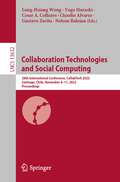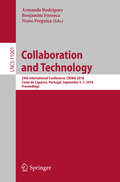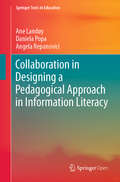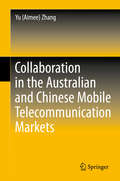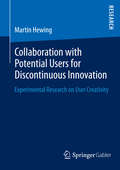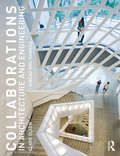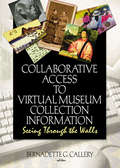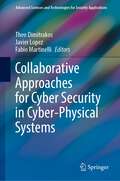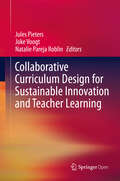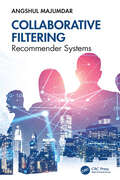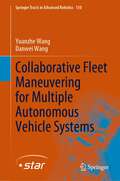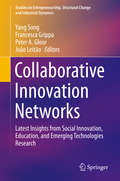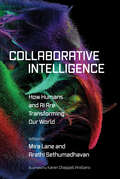- Table View
- List View
Collaboration Technologies and Social Computing: 28th International Conference, CollabTech 2022, Santiago, Chile, November 8–11, 2022, Proceedings (Lecture Notes in Computer Science #13632)
by Nelson Baloian Lung-Hsiang Wong Gustavo Zurita Yugo Hayashi Claudio Alvarez Cesar A. CollazosThis volume constitutes the proceedings of the 28th International Conference on Collaboration Technologies and Social Computing, CollabTech 2022, held in Santiago, Chile during November 8–11, 2022. The 18 full and 4 work-in-process papers presented in this volume were selected from 37 submissions and underwent careful double-blind peer review. The papers focus on innovative technical, human and organizational approaches to expand collaboration support including computer science, management science, design science, cognitive and social science.
Collaboration and Integration in Construction, Engineering, Management and Technology: Proceedings of the 11th International Conference on Construction in the 21st Century, London 2019 (Advances in Science, Technology & Innovation)
by Paul Hampton Syed M. Ahmed Salman Azhar Amelia D. SaulThis book gathers papers presented at the 11th International Conference on Construction in the 21st Century, held in London in 2019. Bringing together a diverse group of government agencies, academics, professionals, and students, the book addresses issues related to construction safety, innovative technologies, lean and sustainable construction, international construction, improving quality and productivity, and innovative materials in the construction industry. In addition, it highlights international collaborations between various disciplines in the areas of construction, engineering, management, and technology. The book demonstrates that, as the industry moves forward in an ever-complex global economy, multi-national collaboration is crucial, and its future growth will undoubtedly depend on international teamwork and alliances.
Collaboration and Technology: 24th International Conference, CRIWG 2018, Costa de Caparica, Portugal, September 5-7, 2018, Proceedings (Lecture Notes in Computer Science #11001)
by Armanda Rodrigues Benjamim Fonseca Nuno PreguiçaThis book constitutes the refereed proceedings of the 24th International Conference on Collaboration and Technology, CRIWG 2018, held in Costa de Caparica, Portugal, in September 2018.The 11 revised full papers presented together with 6 short papers were carefully reviewed and selected from 32 submissions. The papers published in the proceedings of this year span dierent areas of collaborative computing research, from collaborative learning to collaboration through social media and virtual communities.
Collaboration in Designing a Pedagogical Approach in Information Literacy (Springer Texts in Education)
by Ane Landøy Daniela Popa Angela RepanoviciThis Open Access book combines expertise in information literacy with expertise in education and teaching to share tips and tricks for the development of good information literacy teaching and training in universities and libraries. It draws on research, knowledge and pedagogical practice from academia, to teach students how to sift through information to be able to distinguish the important and correct from the unusable. It discusses basic concepts and models of information literacy, as well as strategies for accessing, locating and retrieving information and methods suitable for the assessment and management of information. The book explains many concepts connected to information literacy and discusses pedagogical issues with a view to supporting the practitioner. Each chapter examines one aspect of information literacy, discusses the pedagogical challenges involved and provides suggestions for best practice.
Collaboration in the Australian and Chinese Mobile Telecommunication Markets
by Yu Aimee ZhangA major objective of this book is to identify the key determinants of successful inter-firm collaborations in the telecommunications industry in Australia and China, utilizing both qualitative and quantitative research methods as complementary methodologies. The findings will provide essential information and suggestions for businesses, researchers and policy makers and shed light on how to concretely improve the performance of business collaborations. Inter-firm collaboration has become increasingly important in the global economy, as firms now rely on collaborations to access new resources, new technologies, skills, the latest market information, new markets and knowledge, to accelerate innovation, to reduce costs, and to overcome government policy barriers.
Collaboration with Potential Users for Discontinuous Innovation: Experimental Research on User Creativity
by Martin HewingCreativity and innovation are important drivers of economic welfare and growth in contemporary societies. Collaborating with and learning from users in the early phase of the innovation process has been considered a successful approach to stimulate those creative sparks for organizations. However, the idea of users as innovators has also invoked critical responses especially in the context of innovations that are discontinuous to dominant designs. Martin Hewing and co-author Katharina Hölzle explore the potential that can arise through collaboration with potential users who are not yet users. Those users at the peripheries are perceived to contribute more novel information, by which they better reflect shifts in needs and behavior than current users at the center.
Collaborations in Architecture and Engineering
by Clare Olsen Sinead Mac NamaraCollaborations in Architecture and Engineering focuses on team-building and problem-solving between architects and engineers to prepare you for working together in practice. It provides an overview and foundation for interdisciplinary collaboration so that you can create innovative proposals for optimization, performance, and aesthetic goals. It also shows you how to solve real-world problems and how to engage creatively with technological challenges so that you can be a productive member of any team. The authors, an architect and an engineer, share guidelines learned from their experiences and observations on how to insure productive communication, engage in interdisciplinary discussions, and establish common goals and values. Throughout the book are many case study examples of architect and engineer collaborations––such as those between SANAA and Mutsuro Sasaki, Foster + Partners and Buro Happold, Steven Holl and Guy Nordenson, and SHoP Architects and ARUP. The book also includes a discussion about integrated project delivery (IPD) contracts and administration, so you'll be ready for better integration.
Collaborations in Architecture and Engineering
by Clare Olsen Sinead Mac NamaraThis new edition of Collaborations in Architecture and Engineering explores how to effectively develop creative collaborations among architects and engineers. The authors, an architect and an engineer, share insights gained from their experiences and research on fostering productive communication, engaging in interdisciplinary discussions, and establishing common design goals. Together, they share the tools, methods, and best practices deployed by prominent innovative architects and engineers to provide readers with the key elements for success in interdisciplinary design collaborations. The book offers engaging stories about prominent architect and engineer collaborations––such as those between SANAA and Sasaki and Partners, Adjaye Associates and Silman, Grafton Architects and AKT II, Studio Gang and Arup, Foster + Partners and Buro Happold, Steven Holl Architects and Guy Nordenson and Associates, and among the engineers and architects at SOM. In the second edition, the newly added case studies showcase extraordinary buildings across the globe at a range of scales and typologies, tracing the facets of high-quality collaborations. Through the examples of these remarkable synergies, readers gain insights into innovative design processes that address complex challenges in the built environment. The second edition of Collaborations in Architecture and Engineering is a terrific sourcebook for students, educators, and professionals interested in integrative design practice among the disciplines.
Collaborative Access to Virtual Museum Collection Information: Seeing Through the Walls
by John J Riemer Bernadette G CalleryGet practical tools to successfully develop collaborative online learning projects!Virtual museums provide an opportunity to spark learning through online access to multi-sensory information, and collaboration between sources is needed to efficiently and effectively catalog and present material. Collaborative Access to Virtual Museum Co
Collaborative Approaches for Cyber Security in Cyber-Physical Systems (Advanced Sciences and Technologies for Security Applications)
by Javier Lopez Fabio Martinelli Theo DimitrakosThis book describes cyber-security issues underpinning several cyber-physical systems and several application domains, proposing a common perspective able to collect similarities as well as depict divergences and specific solution methods. Special attention is given to those approaches and technologies that unleash the power of collaboration among stakeholders, in a field based often developed in isolation and segregation of information. Given the pervasively growing dependency of society on IT technology, and the corresponding proliferation of cyber-threats, there is both an imperative need and opportunity to develop a coherent set of techniques to cope with the changing nature of the upcoming cyber-security challenges. These include evolving threats and new technological means to exploit vulnerabilities of cyber-physical systems that have direct socio-technical, societal and economic consequences for Europe and the world. We witness cyber-attacks on large scale infrastructures for energy, transport, healthcare systems and smart systems. The interplay between security and safety issues is now paramount and will be even more relevant in the future. The book collects contributions from a number of scientists in Europe and presents the results of several European Projects, as NeCS, SPARTA, E-CORRIDOR and C3ISP. It will be of value to industrial researchers, practitioners and engineers developing cyber-physical solutions, as well as academics and students in cyber-security, ICT, and smart technologies in general.
Collaborative Construction Information Management (Spon Research)
by Peter Brandon Andrew Baldwin Geoffrey ShenMost construction projects are large and costly. Collaborative working involves two or more stakeholders sharing their efforts and resources to complete the project more effectively and efficiently. Collaborative, integrative and multi-disciplinary teams can tackle the complex issues involved in creating a viable built environment. This tends to be looked at from three interrelated perspectives: the technological, organizational, and social; and of these the key issue is to improve productivity and enable innovation through the empowerment and motivation of people. This book provides insights for researchers and practitioners in the building and construction industry as well as graduate students, written by an international group of leading scholars and professionals into the potential use, development and limitations of current collaborative technologies and practices. Material is grouped into the themes of advanced technologies for collaborative working, virtual prototyping in design and construction, building information modelling, managing the collaborative processes, and human issues in collaborative working.
Collaborative Construction Procurement and Improved Value
by David MoseyThe guide that explores how procurement and contracts can create an integrated team while improving value, economy, quality and client satisfaction Collaborative Construction Procurement and Improved Value provides an important guide for project managers, lawyers, designers, constructors and operators, showing step by step how proven collaborative models and processes can move from the margins to the mainstream. It covers all stages of the project lifecycle and offers new ways to embed learning from one project to the next. Collaborative Construction Procurement and Improved Value explores how strategic thinking, intelligent team selection, contract integration and the use of digital technology can enhance the value of construction projects and programmes of work. With 50 UK case studies, plus chapters from specialists in 6 other jurisdictions, it describes in detail the legal and procedural route maps for successful collaborative teams. Collaborative Construction Procurement and Improved Value: Examines the ways to create an effective contract that will spell success throughout the procurement process Contains helpful case studies from real-world projects and programmes Explores the benefits of the collaborative construction process and how to overcome common obstacles Bridges the gaps between contract law, collaborative working and project management Includes the first analysis of the NEC4 Alliance Contract, the FAC-1 Framework Alliance Contract and the TAC-1 Term Alliance Contract
Collaborative Curriculum Design for Sustainable Innovation and Teacher Learning
by Joke Voogt Jules Pieters Natalie Pareja RoblinThis open access book provides insight into what it takes to actively involve teachers in the curriculum design process. It examines different aspects of teacher involvement in collaborative curriculum design, with specific attention to its implications for sustainable curriculum innovation and teacher learning. Divided into six sections, the book starts out by introducing the notion of collaborative curriculum design and discusses its historical and theoretical foundations. It describes various approaches commonly adopted to actively involve teachers in the (co-)design of curriculum materials. Sections two and three provide examples of what key phases in the curriculum design process - such as needs analysis, design and development, and implementation - look like across various collaborative curriculum design projects. Section four reports on the impact of collaborative curriculum design on student learning, teacher practices, teacher professional growth, and institutional change. Building on the research evidence about the outcomes of collaborative curriculum design, section five focuses on sustainability, scaling-up and curriculum leadership issues, which are key to the continuation and further evolution of curriculum innovations. Future perspectives are addressed in section six with emphasis on the infrastructure of a sustainable curriculum innovation.
Collaborative Design Management
by Stephen Emmitt Kirti RuikarThe design process has always been central to construction, but recent years have seen its significance increase, and the ways of approaching it multiply. To an increasing degree, other stakeholders such as contractors have input at the design stage, and the designer’s role includes tasks that were traditionally the realm of other professions. This presents challenges as well as opportunities, and both are introduced, discussed, and analysed in Collaborative Design Management. Case studies from the likes of ARUP, Buro Happold, VINCI Construction UK Ltd, and CIOB show how technologies (BIM, podcasting), innovative working (information management, collaboration), and the evolution of roles (the designer-contractor interface, environmental compliance) have changed design management as a process. Starting from a basic level, the reader is introduced to the key themes and background to the design management role, including definitions of the responsibilities now commonly involved, and the strategic importance of design. Influential technologies currently in use are evaluated, and the importance they are likely to have in future is explored. This combination of case studies from leading practitioners, clear explanations of design management roles and activities, and an exploration of how to succesfully achieve collaborative design management makes this a highly topical and uniquely valuable book. This is essential reading for professionals and students of all levels interested in construction design management, from all AEC backgrounds.
Collaborative Development for the Prevention of Occupational Accidents and Diseases: Change Laboratory in Workers' Health
by Rodolfo Andrade de Gouveia Vilela Marco Antonio Pereira Querol Sandra Lorena Beltran Hurtado Gislaine Cecília de Oliveira Cerveny Manoela Gomes Reis LopesThis book presents an innovative method to improve workers’ health and prevent occupational accidents: the Change Laboratory, a method of formative intervention that enables the organization's participants to identify, with the help of facilitators, the historical and systemic origins of work processes anomalies (environmental problems, work safety and health, quality and productivity problems, problems related to labor relations, etc). It proposes a cycle of expansive learning that evolves from recognition of the problem to the visualization, testing and consolidation of solutions.The Change Laboratory method was first developed by Finnish researchers in the 90s and has been improved since then by an international network of research centers in ten countries. This volume presents the results of the experiences conducted by the Brazilian research group to apply the methodology to workers’ health programs. It adopts a translational approach and seeks to elaborate a method of intervention that goes beyond the mere diagnostics to present solutions to concrete problems based on systematized and participatory research. Collaborative Development for the Prevention of Occupational Accidents and Diseases - Change Laboratory in Worker's Health will be of interest to both researchers and professionals engaged in developing intervention programs to improve safety and health at work, such as occupational health professionals and researchers, organizational psychologists, safety engineers and public agents working with workers’ health regulations. The book will also be of interest to occupational health students interested in learning how the Change Laboratory method can be applied to this field of research and activity.
Collaborative Engineering: Theory and Practice
by Ali K. Kamrani Emad Abouel NasrThis superb study offers insights into the methods and techniques that enable the implementation of a Collaborative Engineering concept on product design. It does so by integrating capabilities for intelligent information support and group decision-making, utilizing a common enterprise network model and knowledge interface through shared ontologies. The book is also a collection of the latest applied methods and technology from selected experts in this area.
Collaborative Filtering: Recommender Systems
by Angshul MajumdarThis book dives into the inner workings of recommender systems, those ubiquitous technologies that shape our online experiences. From Netflix show suggestions to personalized product recommendations on Amazon or the endless stream of curated YouTube videos, these systems power the choices we see every day.Collaborative filtering reigns supreme as the dominant approach behind recommender systems. This book offers a comprehensive exploration of this topic, starting with memory-based techniques. These methods, known for their ease of understanding and implementation, provide a solid foundation for understanding collaborative filtering. As you progress, you’ll delve into latent factor models, the abstract and mathematical engines driving modern recommender systems.The journey continues with exploring the concepts of metadata and diversity. You’ll discover how metadata, the additional information gathered by the system, can be harnessed to refine recommendations. Additionally, the book delves into techniques for promoting diversity, ensuring a well-balanced selection of recommendations. Finally, the book concludes with a discussion of cutting-edge deep learning models used in recommender systems.This book caters to a dual audience. First, it serves as a primer for practicing IT professionals or data scientists eager to explore the realm of recommender systems. The book assumes a basic understanding of linear algebra and optimization but requires no prior knowledge of machine learning or programming. This makes it an accessible read for those seeking to enter this exciting field. Second, the book can be used as a textbook for a graduate-level course. To facilitate this, the final chapter provides instructors with a potential course plan.Key features:· This is the only book covering 25 years of research on this topic starting from late 90s to the current year.· This book is accessible to anyone with a basic knowledge of linear algebra, unlike other volumes that require knowledge of advanced data analytics.· It covers a wider range of topics than other books. Most others are research oriented and delves deep into a narrow area.· This is the only book written to be a textbook on collaborative filtering and recommender systems.· The book emphasizes on algorithms and not implementation. This makes it agnostic to programming languages. The reader is free to use whatever they are comfortable in, such as Python, R, Matlab, Java, etc.
Collaborative Fleet Maneuvering for Multiple Autonomous Vehicle Systems (Springer Tracts in Advanced Robotics #150)
by Danwei Wang Yuanzhe WangThis book presents theoretical foundations and technical implementation guidelines for multi-vehicle fleet maneuvering, which can be implemented by readers and can also be a basis for future research. As a research monograph, this book presents fundamental concepts, theories, and technologies for localization, motion planning, and control of multi-vehicle systems, which can be a reference book for researchers and graduate students from different levels. As a technical guide, this book provides implementation guidelines, pseudocode, and flow diagrams for practitioners to develop their own systems. Readers should have a preliminary knowledge of mobile robotics, state estimation and automatic control to fully understand the contents in this book. To make this book more readable and understandable, extensive experimental results are presented to support each chapter.
Collaborative Innovation Networks: Latest Insights from Social Innovation, Education, and Emerging Technologies Research (Studies on Entrepreneurship, Structural Change and Industrial Dynamics)
by João Leitão Peter A. Gloor Francesca Grippa Yang SongCollaborative innovation networks are cyberteams of motivated individuals, and are self-organizing emergent social systems with the potential to promote health, happiness and individual growth in real-world work settings.This book describes how to identify and nurture collaborative innovation networks in order to shape the future working environment and pave the way for health and happiness, and how to develop future technologies to promote economic development, social innovation and entrepreneurship. The expert contributions and case studies presented also offer insights into how large corporations can creatively generate solutions to real-world problems by means of self-organizing mechanisms, while simultaneously promoting the well-being of individual workers. The book also discusses how such networks can benefit startups, offering new self-organizing forms of leadership in which all stakeholders are encouraged to collaborate in the development of new products.
Collaborative Innovation in Drug Discovery: Strategies for Public and Private Partnerships (Wiley Series on Technologies for the Pharmaceutical Industry #12)
by Rathnam Chaguturu Ferid MuradCan academia save the pharmaceutical industry? The pharmaceutical industry is at a crossroads. The urgent need for novel therapies cannot stem the skyrocketing costs and plummeting productivity plaguing R&D, and many key products are facing patent expiration. Dr. Rathnam Chaguturu presents a case for collaboration between the pharmaceutical industry and academia that could reverse the industry's decline. Collaborative Innovation in Drug Discovery: Strategies for Public and Private Partnerships provides insight into the potential synergy of basing R&D in academia while leaving drug companies to turn hits into marketable products. As Founder and CEO of iDDPartners, focused on pharmaceutical innovation, Founding president of the International Chemical Biology Society, and Senior Director-Discovery Sciences, SRI International, Dr. Chaguturu has assembled a panel of experts from around the world to weigh in on issues that affect the two driving forces in medical advancement. Gain global perspectives on the benefits and potential issues surrounding collaborative innovation Discover how industries can come together to prevent another "Pharma Cliff" Learn how nonprofits are becoming the driving force behind innovation Read case studies of specific academia-pharma partnerships for real-life examples of successful collaboration Explore government initiatives that help foster cooperation between industry and academia Dr. Chaguturu’s thirty-five years of experience in academia and industry, managing new lead discovery projects and forging collaborative partnerships with academia, disease foundations, nonprofits, and government agencies lend him an informative perspective into the issues facing pharmaceutical progress. In Collaborative Innovation in Drug Discovery: Strategies for Public and Private Partnerships, he and his expert team provide insight into the various nuances of the debate.
Collaborative Intelligence: How Humans and AI Are Transforming Our World
by Mira Lane and Arathi SethumadhavanA deep look into the multifaceted landscape of artificial intelligence, considering AI&’s ethical and societal implications and celebrating its diverse and innovative applications.In this edited collection Collaborative Intelligence, Mira Lane and Arathi Sethumadhavan embark on a captivating exploration of artificial intelligence. The book delves deeply into the dynamic interplay between theory and practice, shedding light on the transformative potential and complexities of AI. For practitioners deeply immersed in the world of AI, Lane and Sethumadhavan offer firsthand accounts and insights from technologists, academics, and thought leaders, as well as a series of compelling case studies, ranging from AI's impact on artistry to its role in addressing societal challenges like modern slavery and wildlife conservation.As the global AI market burgeons, this book enables collaboration, knowledge sharing, and interdisciplinary dialogue. It caters not only to the practitioners shaping the AI landscape but also to policymakers striving to navigate the intricate relationship between humans and machines, as well as academics. Divided into two parts, the first half of the book offers readers a comprehensive understanding of AI's historical context, its influence on power dynamics, human-AI interaction, and the critical role of audits in governing AI systems. The second half unfolds a series of eight case studies, unraveling AI&’s impact on fields as varied as healthcare, vehicular safety, conservation, human rights, and the metaverse. Each chapter in this book paints a vivid picture of AI&’s triumphs and challenges, providing a panoramic view of how it is reshaping our world.
Collaborative Internet of Things (C-IoT)
by Kwok Wu Fawzi BehmannThis book provides a simplified visionary approach about the future direction of IoT, addressing its wide-scale adoption in many markets, its interception with advanced technology, the explosive growth in data, and the emergence of data analytics. IoT business applications span multiple vertical markets. The objective is to inspire creative thinking and collaboration among startups and entrepreneurs which will breed innovation and deliver IoT solutions that will positively impact us by making business processes more efficient, and improving our quality of life. With increasing proliferation of smart-phones and social media, data generated by user wearable/mobile devices continue to be key sources of information about us and the markets around us. Better insights will be gained through cognitive computation coupled with business intelligence and visual analytics that are GIS-based.dia class of applications. This has led to the migration from client/server to cloud computing and services. Security has become and remains to be a key challenge to secure access of content at anytime and anywhere. The introduction of smart phones has generated a wide acceptance and adoption by business, consumer and general population. Today, we see high growth in mobile traffic than landline. Increase longer life battery, introduction of tablets and growth of ecosystem for mobile applications will cause a gradual decline in the growth of PCs and rapid end of life of desktop equipment. The amount of data being created and transmitted over networks from mobile devices and IoT will continue to grow in an explosive way. This, in turn, will impact businesses by entering in a new era of computing that requires systems to process and analyze, in real-time, huge volumes of information known as Big Data and emergence of new applications and services. As networks increase in complexity, concept of virtualization and clouds become of great importance in the evolution of future networks. SDN - Software Defined Networks will enable virtualization of network resources enabled by open source capabilities and interoperability. Hence, we can witness the evolution and acceleration of the next generation cloud architecture, computing and emerging services. The book provides the reader with a quick overview of the evolution of Internet of Things and its impact on Smart Connected Digital Life and emerging Cloud Services comparing trials in the 1990s with current solutions offering and future trends. The underline drivers of innovative change are the scalability of Internet, advancement of wireless technology and accelerated growth of mobility. Broadly, the book is organized into eight chapters and provides a comprehensive overview on emerging cloud services and IoT networking paradigms.
Collaborative Knowledge Management Through Product Lifecycle: A Computational Perspective
by Hongwei Wang Gongzhuang PengThis book not only presents the state-of-the-art research on knowledge modelling, knowledge retrieval and knowledge reuse, but also elaborates the Collaborative Knowledge Management (CKM) paradigm and the architecture for the next generation of knowledge management systems. Although knowledge management has been extensively studied, particularly in the fields of business management and engineering design, there is a lack of systematic methodologies for addressing the integrated and collaborative dimension of knowledge management during the collaborative process of designing and developing complex systems, products, processes and services. The rapid development of information technologies, together with their applications in engineering and management, has laid the foundation for a Collaborative Knowledge Management (CKM) paradigm. The book specifically discusses this paradigm from a computational perspective. By exploring specific research findings underpinning further CKM research and applications and describing methods related to hot research topics and new research areas, the book appeals to professionals, researchers and graduate students who are interested in knowledge management and related topics and who have a basic understanding of information technologies, computational methods, and knowledge management.
Collaborative Learning, Reasoning, and Technology (Rutgers Invitational Symposium On Education Ser.)
by Gijsbert Erkens Cindy E. Hmelo-Silver Angela M. O’DonnellThis volume presents research findings on the use of technology to support learning and reasoning in collaborative contexts. Featuring a variety of theoretical perspectives, ranging from sociocultural to social psychological to information processing views, Collaborative Learning, Reasoning, and Technology includes an international group of authors
Collaborative Logistics and Intermodality: Integration in Supply Chain Network Models and Solutions for Global Environments
by Jorge E. Hernández Dong Li José Elias Jimenez-Sanchez Miguel Gaston Cedillo-Campos Luo WenpingThis book presents new approaches to logistics solutions in global environments, with a special focus on collaborative logistics and intermodality. Contributions in this book are linked to two major initiatives in global logistics - H2020 MSCA-RISE-EU project EC-Asia Research Network on Integration of Global and Local Agri-Food Supply Chains Towards Sustainable Food Security (GOLF), and the International Conference on Logistics & Supply Chain (CiLOG). Topics covered in this book are: global logistics environments in manufacturing industries, key logistic decision-making parameters, global logistics management and its impact on container logistics processes, logistic market clusters and many more.
